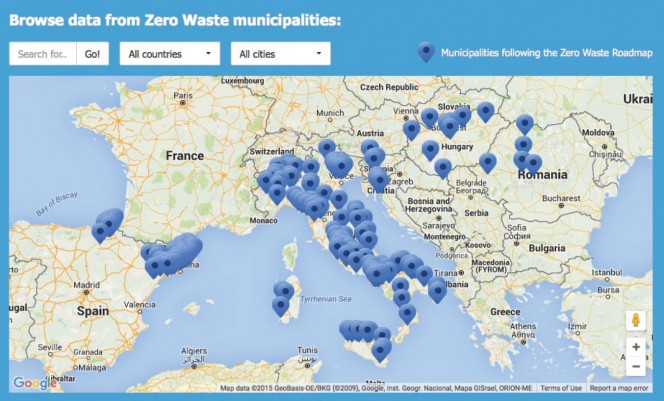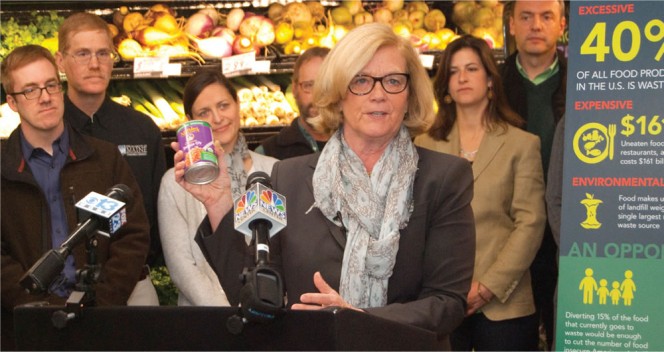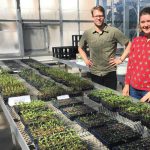BioCycle December 2015
Maine Representative Introduces Food Recovery Act
Congresswoman Chellie Pingree, D-Maine, introduced H.R. 4184, “a bill to decrease the incidence of food waste and for other purposes” that can be cited as the “Food Recovery Act of 2015.” Pingree’s Food Recovery Act takes commonsense steps to reduce food waste while helping feed millions of Americans, and includes elements that are very familiar to BioCycle readers, especially wasted food prevention, composting and anaerobic digestion. H.R. 4184 has five major components:
• Reduce wasted food at the consumer level: Combat consumer confusion by clarifying that “sell-by” dates are manufacturers’ quality suggestions only, and require uniform labeling language; Sponsor national campaign raising awareness on impact of food waste and strategies to decrease wasted food at the household level.
• Reduce wasted food on the farm, in grocery stores and restaurants: Extend and expand tax deductions for farmers, retailers, and restaurants that donate high-quality food to organizations serving people who are food insecure; Strengthen federal liability protections for food donation; Invest in storage and distribution programs to help food banks maximize their resources.
• Reduce wasted food in schools: Encourage school cafeterias to purchase lower-price “ugly” fruits and vegetables; Expand grant programs to educate students about food waste and encourage food recovery; Strengthen connection between schools and farms to give both more resources to combat food waste.
• Reduce wasted food throughout the federal government, including Congress and the military: Create an Office of Food Recovery within USDA to coordinate federal activities related to measuring and reducing food waste and implementing food recovery initiatives; Require food service providers that contract with the federal government, including Congressional cafeterias, U.S. military bases, and federal prisons, to donate surplus food to organizations like food banks, food pantries, and soup kitchens.
• Reduce wasted food going to landfills: Encourage composting as a conservation practice eligible for support under USDA’s conservation programs; Support food waste-to-energy projects at the farm, municipal, and county levels, while ensuring that edible food that could feed hungry people is not being diverted to energy production; Create infrastructure funds to support construction of large-scale composting and food waste-to-energy facilities in states that restrict food waste going to landfill.
• Reduce wasted food through research: Direct USDA to develop new technologies to increase shelf life of fresh food; Require USDA to establish standards for how to estimate the amount of wasted food at the farm level.
European Zero Waste Cities Map
 At a December 3rd conference in Paris, Zero Waste: A Key Solution Pathway for a Low Carbon Future, Zero Waste Europe (ZWE) officially launched the “Zero Waste Cities” map of European municipalities committed to moving towards zero waste. The mapping exercise “aims to increase the visibility and the accountability of those towns that have dared to step away from the outdated ‘recycle, burn and bury’ paradigm and into the new zero waste paradigm of ‘rethink, reduce, reuse and recycle’,” notes a ZWE press release. The first European municipality to adopt a zero waste goal was Capannori, Italy back in 2008, adds ZWE. Since then, more than 300 municipalities from seven countries have joined the network and many more are expected to join in the coming years. “Some towns are already above 80 percent recycling and many others know they want to get there in less than 10 years,” says Joan Marc Simon, ZWE’s Director. “We look forward to welcoming new cities to the network.”
At a December 3rd conference in Paris, Zero Waste: A Key Solution Pathway for a Low Carbon Future, Zero Waste Europe (ZWE) officially launched the “Zero Waste Cities” map of European municipalities committed to moving towards zero waste. The mapping exercise “aims to increase the visibility and the accountability of those towns that have dared to step away from the outdated ‘recycle, burn and bury’ paradigm and into the new zero waste paradigm of ‘rethink, reduce, reuse and recycle’,” notes a ZWE press release. The first European municipality to adopt a zero waste goal was Capannori, Italy back in 2008, adds ZWE. Since then, more than 300 municipalities from seven countries have joined the network and many more are expected to join in the coming years. “Some towns are already above 80 percent recycling and many others know they want to get there in less than 10 years,” says Joan Marc Simon, ZWE’s Director. “We look forward to welcoming new cities to the network.”
U.S. EPA Announces “Call To Action” To Reduce Food Waste
U.S. EPA Assistant Administrator Mathy Stanislaus announced a “Call To Action” to help meet the U.S. EPA’s and U.S. Department of Agriculture’s goal to reduce food loss and waste by 50 percent by 2030. Stanislaus issued the Call To Action during the Closing Plenary of the Food Recovery Summit, held November 16-18 in Charleston, South Carolina. “We want to announce an Action Plan to meet the goal on Earth Day 2016,” he stated. “What has to be done to meet this goal? What has to change? We are seeking a diverse plan made by representatives of all sectors of the food life cycle.” Stanislaus and other EPA officials participated in sessions and roundtables throughout the summit. They emphasized that EPA is open to new and “disruptive” ideas and strategies to prevent wasted food, increase food recovery, and assist in development of processing infrastructure for nonedible food. “We are pushing all of you to help develop a concrete plan that you can sign on to and commit your resources [to implement],” concluded Stanislaus.
New Industry Best Practices Guide
The Food Waste Reduction Alliance (FWRA) released an updated guide with practical steps and examples to help food manufacturers, food retailers, restaurants and food service operators cut food waste. The second annual “Best Practices and Emerging Solutions” guide highlights how companies can begin or expand their food donation or food waste diversion programs. FWRA is a cross-sector industry initiative led by the Food Marketing Institute (FMI), the Grocery Manufacturers Association (GMA) and the National Restaurant Association (NRA). “The real value this project offers is the perspective of industry — compiled by companies for companies,” notes Christy Cook, Director of Sustainability Performance and Field Support for Sodexo, whose efforts in food waste reduction are highlighted in this year’s guide. “It shares industry successes and suggestions around how to overcome potential food donation obstacles such as liability issues, transportation constraints and insufficient storage and refrigeration at food banks. It also highlights ways to recycle food waste such as recovering energy from food waste materials and redirection of organic materials.”
The guide is filled with case studies, model practices and emerging solutions compiled across the hunger relief and waste management sectors and includes more than 30 member companies throughout the food chain. Examples of success stories include:
The Campbell Soup Company’s partnership with the Food Bank of South Jersey and the New Jersey agricultural community in which undersized peaches headed for disposal were given new life as shelf-stable peach salsa. Just Peachy is sold at retail with proceeds benefitting the Food Bank of South Jersey.
ConAgra Foods, Inc.’s strategy to change the way it transitions from one pudding flavor to another in a manufacturing facility by creating blended flavors rather than waste product when flushing the manufacturing line. The mixed-flavor pudding is donated, reducing manufacturing loss.
Food service operators such as Aramark Corporation and Sodexo have seen dramatic reductions in food waste by simply getting rid of trays in dining halls and cafeterias.
Darden Restaurants’ and Yum! Brands’ partnership with Food Donation Connection to establish the Darden Harvest and Yum! Harvest programs, which coordinate food donations to food banks and other charitable organizations as an alternative to discarding prepared foods.
Supermarkets such as Hannaford Supermarkets and Weis Markets, Inc. are making strides in improvements to their food donation programs, enabling them to share best practices.
Food Recovery Challenge — 2015 Awards
The U.S. Environmental Protection Agency’s (EPA) Food Recovery Challenge initiative presents annual awards to participants and endorsers. Nearly 800 governments, businesses and organizations participated in the Food Recovery Challenge (FRC) in 2014, including grocers, educational institutions, sports and entertainment venues and restaurants. Participants diverted almost 606,000 tons of wasted food from landfills or incinerators in 2014, nearly 88,600 tons of which were donated to people in need, according to EPA. The agency provides tools, resources and support to help participants establish baselines, set objectives, track progress and realize their waste reduction goals. EPA recognizes FRC participants and endorsers with awards in two categories: data-driven and narrative. The data-driven award recipients achieved the highest percent of wasted food diversion and prevention in their sector in 2014. Narrative award winners excelled in the areas of source reduction, leadership, innovation, education and outreach, and endorsement.
Awardees in the data-driven category are: Salem State University; Pearl City High School; Sprouts Farmers Market; Ortega National Parks, LLC/White Sands Trading Company; Serendipity Catering; and SAVOR…Chicago-McCormick Place South. The narrative category winners and their categories include: Crystal Creamery (Innovation), which diverts organics from its wastewater treatment plant to a local dairy farm with an anaerobic codigestion facility; Massachusetts Department of Environmental Protection (Endorser), for leading food recovery outreach and technical assistance efforts in the state and for its direction of the RecyclingWorks in MA program, administered under contract by the Center for EcoTechnology; and MB Financial Park at Rosemont/Village of Rosemont — a sports and entertainment venue — and its sustainability partner, Bright Beat (Leadership), for implementing key infrastructure upgrades to help divert wasted food from landfills. The park’s program helped 1,000 employees and 1.6 million visitors keep food recovery and waste diversion top of mind resulting in the recovery of more than 150 tons of organics.











